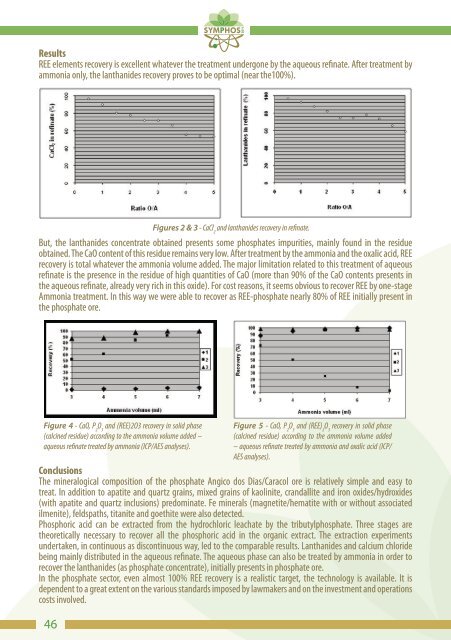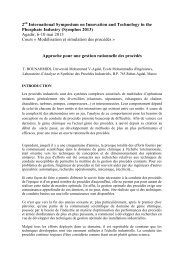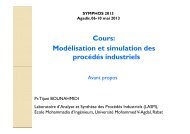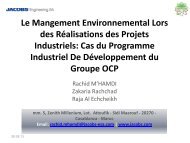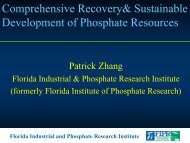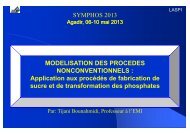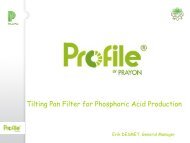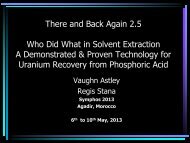Abstract SYMPHOS 2011
Abstract SYMPHOS 2011
Abstract SYMPHOS 2011
You also want an ePaper? Increase the reach of your titles
YUMPU automatically turns print PDFs into web optimized ePapers that Google loves.
Results<br />
REE elements recovery is excellent whatever the treatment undergone by the aqueous refinate. After treatment by<br />
ammonia only, the lanthanides recovery proves to be optimal (near the100%).<br />
But, the lanthanides concentrate obtained presents some phosphates impurities, mainly found in the residue<br />
obtained. The CaO content of this residue remains very low. After treatment by the ammonia and the oxalic acid, REE<br />
recovery is total whatever the ammonia volume added. The major limitation related to this treatment of aqueous<br />
refinate is the presence in the residue of high quantities of CaO (more than 90% of the CaO contents presents in<br />
the aqueous refinate, already very rich in this oxide). For cost reasons, it seems obvious to recover REE by one-stage<br />
Ammonia treatment. In this way we were able to recover as REE-phosphate nearly 80% of REE initially present in<br />
the phosphate ore.<br />
Figure 4 - CaO, P 2 O 5 and (REE)2O3 recovery in solid phase<br />
(calcined residue) according to the ammonia volume added –<br />
aqueous refinate treated by ammonia (ICP/AES analyses).<br />
Conclusions<br />
The mineralogical composition of the phosphate Angico dos Dias/Caracol ore is relatively simple and easy to<br />
treat. In addition to apatite and quartz grains, mixed grains of kaolinite, crandallite and iron oxides/hydroxides<br />
(with apatite and quartz inclusions) predominate. Fe minerals (magnetite/hematite with or without associated<br />
ilmenite), feldspaths, titanite and goethite were also detected.<br />
Phosphoric acid can be extracted from the hydrochloric leachate by the tributylphosphate. Three stages are<br />
theoretically necessary to recover all the phosphoric acid in the organic extract. The extraction experiments<br />
undertaken, in continuous as discontinuous way, led to the comparable results. Lanthanides and calcium chloride<br />
being mainly distributed in the aqueous refinate. The aqueous phase can also be treated by ammonia in order to<br />
recover the lanthanides (as phosphate concentrate), initially presents in phosphate ore.<br />
In the phosphate sector, even almost 100% REE recovery is a realistic target, the technology is available. It is<br />
dependent to a great extent on the various standards imposed by lawmakers and on the investment and operations<br />
costs involved.<br />
46<br />
Figures 2 & 3 - CaCl 2 and lanthanides recovery in refinate.<br />
Figure 5 - CaO, P 2 O 5 and (REE) 2 O 3 recovery in solid phase<br />
(calcined residue) according to the ammonia volume added<br />
– aqueous refinate treated by ammonia and oxalic acid (ICP/<br />
AES analyses).


